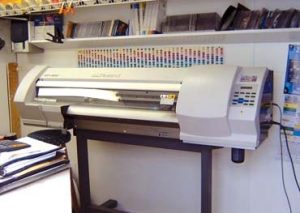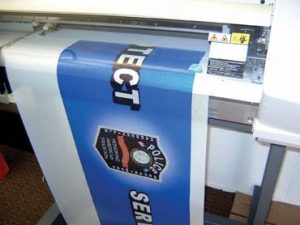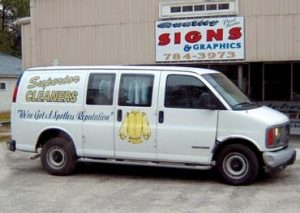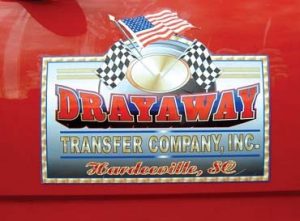Digital Printing
The Leap to Digital
Small signshops share their stories about digital printing.
Published
18 years agoon
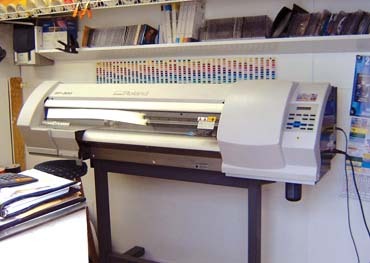
From equipment manufacturers to signshops, the verdict is unanimous: Digital printing is a necessary and sweeping trend in the sign industry. Small signshops agree, to stay competitive, it’s imperative to keep up with the latest trends, which, for them also means investing in a digital printer.
Signshops contacted by ST cautioned against impulsively buying digital printers without the proper research. And many explained different marketing approaches for their shops’ digital-printing capabilities. But signshop owners interviewed for this article all regarded digital printing as a profitable addition to their business.
Galaxy Signs
Barry Krem and his wife, Christine, own Galaxy Signs (St. Louis), a full-service signshop equipped with a Mutoh Falcon Outdoor 62-in., eco-solvent digital printer.
The shop, which employs four people and opened in August 2005, creates digital prints for vehicle graphics, tradeshow displays and POP displays. Digital printing accounts for roughly 40% of the shop’s business, Krem said, but he hopes that figure will eventually be between 75 and 80%.
We expect that segment of our business to grow the fastest,” he said. “We expect it to grow because we’re marketing our digital-printing capabilities.”
For Krem, that means business-to-business advertising. He keeps an eye out for trade vans, leafs through the phonebook and calls local businesses to spread the word.
“We’re moving out as we’re gaining word of mouth; we’re gaining referrals,” Krem said. “You just have to start somewhere.”
Galaxy Signs also attends various tradeshows to promote its digital printing. “You almost have to be physically present,” Krem said.
Although Krem has 15 years of signmaking experience, he had no background in digital printing before he opened his shop. He and his staff were trained to use the printer and accompanying RIP software, but Krem says each day brings new lessons.
“Every job we learn a little something better,” he said.
One of the main challenges Krem faces is staying competitive with color. “In the long run, color management becomes vital.”
He advises signshops looking to get a foot into the digital-printing door to “do your homework. The market is there.”
Highet Kräcker Design
Highet Kräcker Design (Lumberton, NC) has been in operation for five years. Owned by Bob Highet and Trevor Kräcker, the signshop, a team of 12, focuses primarily on vehicle graphics.
The shop made the leap to digital a year ago, Kräcker said, after they determined it was in demand. “We had the sales volume to justify it,” he said.
They now have two digital printers: Mutoh’s Falcon Outdoor 36- and 62-in. printers. Digital printing, Kräcker said, constitutes 62% of the signshop’s business, and the shop has clients throughout the United States.
Kräcker said his main marketing tactics for digital printing are through word of mouth, reputation, referrals and the shop’s website. And customers, he said, are looking for the most competitive prices, printing quality and production time.
His advice to newcomers: Don’t impulsively buy an expensive digital printer without doing the research. “They don’t need to go big right away,” he said.
Quality Signs & Graphics
At 62 years old, Paul Bathe, co-owner of Quality Signs & Graphics (Hardeeville, SC), purchased a Roland DGA Corporation SP300 30-in. digital printer for his signshop, which has been in business for 17 years.
The mom-and-pop operation, run by Bathe and his wife, said customer demand warranted getting into digital printing.
“They would walk in the door, and they would hand you an item that you could not do in vinyl,” he said. “So, because the industry is changing . . . we moved forward with technology and business.”
Digital printing, Bathe said, now constitutes between 20 and 22% of the signshop’s business. He uses the printer to produce magnetic signs, vehicle graphics, banners and other, smaller jobs.
Bathe said onsite training for using the printer was “minimal,” but “every day you come up with some new challenge, and if you just apply yourself with the programs you’ve got, you can get the answer.”
Promoting their product, Bathe said, is a hands-on task. He and his wife hand out brochures and peel-and-stick business cards whenever they come across work-site vehicles. The signshop is located on the main highway in Hardeeville, so the work itself, Bathe said, draws attention.
Bathe said signshops looking to add digital printing should analyze their customers’ needs.
“They need to look at their demand – what is their customer saying to them that they want or need,” he said.
Bathe echoed Kräcker’s advice to conduct hefty research before committing to a digital printer.
“Before you buy that piece of equipment, you need to research who you’re buying it from and make sure you get after-sales service,” he said.
Fastsigns
It isn’t just independent signshops that are going digital. Franchises such as Gregory Woelfel’s Fastsigns shop (Farmington Hills, MI), a team of seven, are catching up to the trend as well.
Woelfel said the shop bought its first digital printer, a Gerber Edge, in 1996. “That was kind of our entry into digital printing,” he said.
The shop later purchased an HP 2500, 36-in., inkjet printer and an HP 5000, 42-in., inkjet printer. A year and a half ago, Woelfel said, they bought a Mimaki JV3160, 60-in., solvent printer.
Digital printing, Woelfel said, now comprises 70% of the franchise’s business; the other 30% is cut vinyl. Plus, he said, going digital has cut down on material costs and eased the shop’s pricing structure.
“One of the things digital printing does for you is it can significantly simplify your pricing structure,” Woelfel said.
Woelfel is planning on eventually buying a flatbed printer, which, he said, many Fastsigns franchises have already done.
“We definitely plan on doing it,” he said.
Woelfel said his printer choice depends on the color rendition and resolution required for the job. He uses the Mimaki to print onto vinyl, mesh banners, fabrics and paper for short-term graphics, and the HP printers for such applications as tradeshow and POP graphics, where resolution and color are of primary importance.
Marketing for the shop’s digital printing was a seemingly risky move. Woelfel said they started by identifying certain projects and then giving away a digital-print version along with the commissioned print.
“It was probably the wisest marketing technique anyone has ever recommended to me,” Woelfel said. “There’s nothing like them [customers] holding it in their hand.”
Before buying a digital printer, Woelfel said it’s imperative to ensure the manufacturer has a proven track record and to analyze customer needs to determine what output is needed.
“If it’s going to be a moneymaker for you, make sure it’s up and running [properly],” he said.
From equipment manufacturers to signshops, the verdict is unanimous: Digital printing is a necessary and sweeping trend in the sign industry. Small signshops agree, to stay competitive, it’s imperative to keep up with the latest trends, which, for them also means investing in a digital printer.
Signshops contacted by ST cautioned against impulsively buying digital printers without the proper research. And many explained different marketing approaches for their shops’ digital-printing capabilities. But signshop owners interviewed for this article all regarded digital printing as a profitable addition to their business.
Galaxy Signs
Barry Krem and his wife, Christine, own Galaxy Signs (St. Louis), a full-service signshop equipped with a Mutoh Falcon Outdoor 62-in., eco-solvent digital printer.
The shop, which employs four people and opened in August 2005, creates digital prints for vehicle graphics, tradeshow displays and POP displays. Digital printing accounts for roughly 40% of the shop’s business, Krem said, but he hopes that figure will eventually be between 75 and 80%.
“We expect that segment of our business to grow the fastest,” he said. “We expect it to grow because we’re marketing our digital-printing capabilities.”
For Krem, that means business-to-business advertising. He keeps an eye out for trade vans, leafs through the phonebook and calls local businesses to spread the word.
“We’re moving out as we’re gaining word of mouth; we’re gaining referrals,” Krem said. “You just have to start somewhere.”
Galaxy Signs also attends various tradeshows to promote its digital printing. “You almost have to be physically present,” Krem said.
Although Krem has 15 years of signmaking experience, he had no background in digital printing before he opened his shop. He and his staff were trained to use the printer and accompanying RIP software, but Krem says each day brings new lessons.
“Every job we learn a little something better,” he said.
One of the main challenges Krem faces is staying competitive with color. “In the long run, color management becomes vital.”
He advises signshops looking to get a foot into the digital-printing door to “do your homework. The market is there.”
Highet Kräcker Design
Highet Kräcker Design (Lumberton, NC) has been in operation for five years. Owned by Bob Highet and Trevor Kräcker, the signshop, a team of 12, focuses primarily on vehicle graphics.
The shop made the leap to digital a year ago, Kräcker said, after they determined it was in demand. “We had the sales volume to justify it,” he said.
They now have two digital printers: Mutoh’s Falcon Outdoor 36- and 62-in. printers. Digital printing, Kräcker said, constitutes 62% of the signshop’s business, and the shop has clients throughout the United States.
Kräcker said his main marketing tactics for digital printing are through word of mouth, reputation, referrals and the shop’s website. And customers, he said, are looking for the most competitive prices, printing quality and production time.
His advice to newcomers: Don’t impulsively buy an expensive digital printer without doing the research. “They don’t need to go big right away,” he said.
Quality Signs & Graphics
At 62 years old, Paul Bathe, co-owner of Quality Signs & Graphics (Hardeeville, SC), purchased a Roland SP300 30-in. digital printer for his signshop, which has been in business for 17 years.
The mom-and-pop operation, run by Bathe and his wife, said customer demand warranted getting into digital printing.
“They would walk in the door, and they would hand you an item that you could not do in vinyl,” he said. “So, because the industry is changing . . . we moved forward with technology and business.”
Digital printing, Bathe said, now constitutes between 20 and 22% of the signshop’s business. He uses the printer to produce magnetic signs, vehicle graphics, banners and other, smaller jobs.
Bathe said onsite training for using the printer was “minimal,” but “every day you come up with some new challenge, and if you just apply yourself with the programs you’ve got, you can get the answer.”
Promoting their product, Bathe said, is a hands-on task. He and his wife hand out brochures and peel-and-stick business cards whenever they come across work-site vehicles. The signshop is located on the main highway in Hardeeville, so the work itself, Bathe said, draws attention.
Bathe said signshops looking to add digital printing should analyze their customers’ needs.
“They need to look at their demand – what is their customer saying to them that they want or need,” he said.
Bathe echoed Kräcker’s advice to conduct hefty research before committing to a digital printer.
“Before you buy that piece of equipment, you need to research who you’re buying it from and make sure you get after-sales service,” he said.
Fastsigns
It isn’t just independent signshops that are going digital. Franchises such as Gregory Woelfel’s Fastsigns shop (Farmington Hills, MI), a team of seven, are catching up to the trend as well.
Woelfel said the shop bought its first digital printer, a Gerber Edge, in 1996. “That was kind of our entry into digital printing,” he said.
The shop later purchased an HP 2500, 36-in., inkjet printer and an HP 5000, 42-in., inkjet printer. A year and a half ago, Woelfel said, they bought a Mimaki JV3160, 60-in., solvent printer.
Digital printing, Woelfel said, now comprises 70% of the franchise’s business; the other 30% is cut vinyl. Plus, he said, going digital has cut down on material costs and eased the shop’s pricing structure.
“One of the things digital printing does for you is it can significantly simplify your pricing structure,” Woelfel said.
Woelfel is planning on eventually buying a flatbed printer, which, he said, many Fastsigns franchises have already done.
“We definitely plan on doing it,” he said.
Woelfel said his printer choice depends on the color rendition and resolution required for the job. He uses the Mimaki to print onto vinyl, mesh banners, fabrics and paper for short-term graphics, and the HP printers for such applications as tradeshow and POP graphics, where resolution and color are of primary importance.
Marketing for the shop’s digital printing was a seemingly risky move. Woelfel said they started by identifying certain projects and then giving away a digital-print version along with the commissioned print.
“It was probably the wisest marketing technique anyone has ever recommended to me,” Woelfel said. “There’s nothing like them [customers] holding it in their hand.”
Before buying a digital printer, Woelfel said it’s imperative to ensure the manufacturer has a proven track record and to analyze customer needs to determine what output is needed.
“If it’s going to be a moneymaker for you, make sure it’s up and running [properly],” he said.Roland DGA Corporation
SPONSORED VIDEO
Introducing the Sign Industry Podcast
The Sign Industry Podcast is a platform for every sign person out there — from the old-timers who bent neon and hand-lettered boats to those venturing into new technologies — we want to get their stories out for everyone to hear. Come join us and listen to stories, learn tricks or techniques, and get insights of what’s to come. We are the world’s second oldest profession. The folks who started the world’s oldest profession needed a sign.
You may like
Advertisement
Subscribe

Magazine
Get the most important news
and business ideas from Signsofthetimes Magazine.
Advertisement
Most Popular
-

 Tip Sheet1 week ago
Tip Sheet1 week agoAlways Brand Yourself and Wear Fewer Hats — Two of April’s Sign Tips
-

 Ask Signs of the Times3 days ago
Ask Signs of the Times3 days agoWhy Are Signs from Canva so Overloaded and Similar?
-

 Photo Gallery23 hours ago
Photo Gallery23 hours ago30 Snapshots of the 2024 ISA Sign Expo
-

 Real Deal1 week ago
Real Deal1 week agoA Woman Sign Company Owner Confronts a Sexist Wholesaler
-

 Benchmarks5 days ago
Benchmarks5 days ago6 Sports Venue Signs Deserving a Standing Ovation
-

 Editor's Note2 weeks ago
Editor's Note2 weeks agoWhy We Still Need the Women in Signs Award
-

 Women in Signs1 week ago
Women in Signs1 week ago2024 Women in Signs: Megan Bradley
-

 Photo Gallery1 week ago
Photo Gallery1 week ago21 Larry Albright Plasma Globes, Crackle Tubes and More

